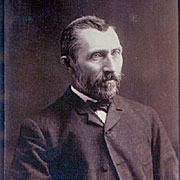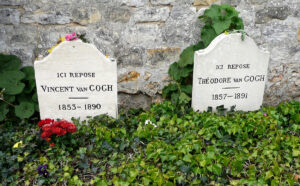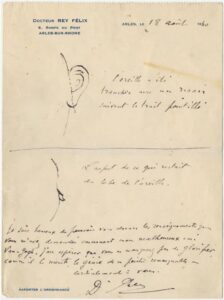Van Gogh’s Severed Ear Reportedly Found in Provence
“How could it be found?” declares Mademoiselle De Lune. “It was never lost.”
I’d heard the quaint whispers: “They found Van Gogh’s ear.” Heard they found an ear – funny stuff. But this improbable discovery was no laughing matter. Rumors were rife and flew around like so much paint onto a Jackson Pollock canvass – that the fabled ear of perhaps the art world’s most influential Impressionist had been found. These rumors did not demonstrate explicitly that the ear had been found, but created an impression that the ear had been found. Was this just an eerie case of life imitating art?
To dispel this absurd rumor required some sly sleuthing. Only then could it be relegated to the clickbait trash heap of e-history. But what if it wasn’t dispel-able. What if this cockamamie tale was true? It would turn the art world on its…oh what’s the word?
And that’s where I enter the painting. My name is Dr. Ellison Archibald Jones (of the Canterbury Jones’s) and I’m an untouchably tenured Art History professor at Balliol College at Oxford University in England. My lofty perch in academia allows me to indulge my deepest passion – locating, retrieving and otherwise restoring lost appendages to dis-armed or defaced sculptures.
Balliol College had always been very generous in rewarding me with sabbaticals due in large part to my prodigious fundraising skills and my popularity among art patrons. My recently published book Art: The 4th R, has added to my fame and is now in its 3rd printing (the first two printings being smudged).
To convey a sense of my expertise and qualifications in spearheading this caper, I’ve provided a brief résumé of my achievements:
Making My Reputation in 3 Landmark Events
- June 1997 – It was me who, at the Galleria dell’Accademia di Firenze found and reattached the marble penis of Michelangelo’s David after it was knocked-off by an angry member of the museum’s docents. Both members went missing for 2 weeks until I caught the angry member trying to sell the stony member to the rival crosstown Uffizi Gallery.
- April 2001 – Whereas thugs earn street cred for acts of criminality, I earned my excavation cred on an archaeological dig at Hisarlik (Troy) in Anatolia, Turkey where I uncovered a mass grave of pillaged Greek statues. And in this trove of random limbs and trashed torsos, I reposed for hours meditating on the rude display before me. Using this grisly pile of toppled and defaced statues as guided imagery, I began to envision the statues in their original fully formed state. My insights were almost criminal if I hadn’t come by them so honestly. It was then I espied and recognized the left limb of the armless Venus de Milo.
The statue was residing in Paris and the limb was here in Troy. Treating the detached marble appendage as if it were still alive and time was of the essence, I had it packed in dry ice and shipped to the Louvre where its famous mothership was on display. A team of international art restorers skilled in the art of micro-marble surgery drilled, screwed and reattached it seamlessly to her shapely torso. I’m happy to report that the Venus de Milo now has complete use of her stationary arm.
- November 2003 – A similar occurrence happened as I was excavating at the Giza pyramid complex near Cairo. While digging near the Well of the Souls, I discovered the left nostril of the de-nosed Sphinx. My discovery catapulted me to B-list celebrity status. That same team of international art restorers was reassembled and by applying micro-rhinoplasty techniques they reattached the nostril and I’m told that the Sphinx now smells great. My reputation made I was pleased to cast the deciding vote against using Crest Teeth Whitening Strips to brighten-up the Sphinx’s smile.
These important restorations in the field of art history have provided me a certain swashbuckling star power in the brawny academic manner of Indiana Jones. But being so very English, my moniker is the somewhat less adventurous-sounding: Canterbury Jones. My unbidden cachet has enabled me to write my own ticket. In this case a ticket to the South of France for a 3-month long sabbatical (really a paid vacation – academia has such unnecessary and grandiose phrases) with my dear wife Prudence. And it is here, in the land of sun and sea, where I began the case I call Canterbury Jones and the Tale of the Lost Ear. A case that was not to be a run-of-the-mill Canterbury Tale.
It so happened the Vincent van Gogh Museum in Amsterdam had received concerning reports from Amputee International that the great one’s ear was in the vicinity of Provence and possibly still alive. They quite naturally enlisted yours truly to either debunk or verify the ear’s existence. In short order the museum’s board of directors called for a hearing into the ear. An ear hearing that I attended in order to provide the hearing aid. Later they voted anonymously for me to launch an investigation. I had hoped they had voted unanimously, but I settled for anonymously. At least it wasn’t posthumously.
Fresh from the museum’s lukewarm validation, I returned to Arles and with my magnifying lens in hand and my ear to the ground I commenced to sleuthing to determine whether this severed ear was the cartilage in question or a prosthetic hoax. I also brought my portable “23 and Me” genetic testing kit. I formulated plans to reconnoiter the famous Yellow House in Arles where Vincent van Gogh painted his most famous pieces including Starry Night and Sunflowers. True, the great one hadn’t been there in over 131 years, but you never know. Clearly, there was work to do.
It’s one thing to locate and reattach the long lost arm of the Venus de Milo, it’s quite another to match the actual ear to the head of an Impressionist, dead for 131 years. But who doesn’t like a challenge in a field I practically invented? Was there an ear out there? And if so was blood still coursing through this cartilaginous auricle? Was it Vincent van Gogh’s? When it got cold, did it have a little muff to wear? We’ll get to all that, but first let’s pay a cursory examination to the sketchy life of Vincent van Gogh.
Vincent van Gogh – A Miniature Portrait

Discovered in an antique shop in 1990, this is the only known photo of the artist. Its authenticity is not fully validated.
In an effort to present a proper portrait of Vincent van Gogh, his brief biography will be painted in the same broad brushstrokes he employed to produce his exquisite works. Any responsible biography of Vincent van Gogh should really be written in 2 parts; Vincent van Gogh the Man and Vincent van Gogh the Ear. And the first word that should be applied to Vincent van Gogh is troubled. So it is incumbent upon me to begin thusly. Troubled Vincent Willem van Gogh and his left ear were both born with a great attachment to each other in Groot-Zundert in the Netherlands on 30 March 1853. Anyone born in a place clunkily named Groot-Zundert might be troubled too. I get that. Even though he was Dutch, Vincent van Gogh is most associated with France – the South of France and sun-drenched Arles in Provence most specifically.
He was an incredibly tortured and brilliantly creative soul who never married, never had children and frequented whorehouses – sometimes with his artisan friend Paul Gauguin. During the technology-deficient early Belle Époque Period (1870-90) there was no electricity, no Wi-Fi and no drive-thru Starbucks (or drive-thru anything for that matter). Modernity was on the way, but hadn’t quite arrived yet so there was a lot of lackluster and dispiriting down time.
While the primitive times may not have provided Van Gogh much satisfaction, whoremongering did. During France’s 3rd Republic (1870-1940) it was essentially state-sponsored. There were celebrated brothels such as The Sphinx and Chabanais frequented by some of society’s most prominent men (and even a few women). The government registered prostitutes and took a cut of the action while imposing minimum hygienic and behavioral standards. Serving male carnal interest was a priority for the 3rd Republic. One can almost imagine a constitutional amendment which read: “A well-regulated body being essential to male happiness, the right to bare women shall not be infringed.” Sound familiar?
But perhaps all this attention to late 19th century French whorehouses is best left to another more lurid discussion. Point being brothels were a mainstay of French culture and that Vincent van Gogh and his friends partook of this fleshy candy store was hardly anomalous.
Vincent van Gogh’s younger brother Theo was a solicitous soul. He regularly lent his dissolute brother both financial and moral support. Van Gogh’s artistic friends included Paul Gauguin (famed Impressionist noted for having 3 u’s in his name), Emile Bernard (a lesser known, but highly adroit painter) and Henri Toulouse-Lautrec (the elfin artist was supremely talented and also supremely debauched). The unstable Van Gogh had tempestuous relationships with each of them.
Vincent van Gogh achieved neither fame nor fortune during his lifetime which ended by his own hand on 29 July 1890. Most of the 2100 artworks he produced were created during the incredibly prolific last 2 years of his life. But in his early life he worked as an art dealer in London. Finding this work unfulfilling, he grew morose and turned to religion. He spent years ministering at a Christian mission in Belgium which didn’t brighten his outlook much either. In fact, while ministering to poor coal miners, he was fired by the Church for being both overzealous in his approach and unduly ascetic in his life. He didn’t begin painting till he was 28 and considering that he died at age 37 punctuates just what an artistic dynamo he was.
A Tender, Artistic Psyche and the Pain of Genius
Vincent van Gogh experienced many psychotic episodes and was institutionalized for a time. One can only imagine how unenlightened and ineffectual his medieval treatments were: restraints, chewing his porridge 100 times before swallowing, cold baths etc. Just like Detective John Shaft, Van Gogh was a complicated man. Owing to the dark and mercurial artistic well he drew from, doctors said he blew right through the usual dichotomy of simple bi-polar disorder and straight into a never before seen case of tri-polar disorder.
His comportment exhibited a classic case of the strangely wired, misunderstood genius who, like a savant, is able to access and express creative realms other more stable geniuses cannot penetrate. He was a uniquely qualified outlier with kaleidoscopic keys to a psychoactive kingdom. His genius was to channel the hallucinatory kinetic energy coursing through his mind onto canvass for all to see.
In 1888, when ill from drink and suffering from smokers’ cough, he moved to Arles and lived with Paul Gauguin in what became known as the Yellow House. It was here, in 4 rented rooms, he achieved an artistic breakthrough. He began painting lush landscapes, swirling suns and animated sunflowers in bold, dramatic brushstrokes; infusing his canvasses with raw emotion, urgency and movement. It seems the concrescence of ill health, a peculiar psychoactive mind, artistic synergies with Gauguin and a salubrious environment in Arles blossomed a new post-Impressionistic technique – the one most associated with him in the popular imagination. The troubled genius was in full flower now, although he was probably unaware of it. Pic yellow house
When he died in 1890, a newspaper obituary wryly noted: On 29 July 1890, the artist Vincent van Gogh became Vincent van Went. He has passed and he is now past tense.
Ear Ye, Ear Ye, Ear Ye
We all know the old aphorism; a doctor who treats himself has a fool for a patient. Well the same holds true for a psychotic artist trying to slay his demons with a scalpel. Not a good match. Van Gogh’s legacy is certainly bound to the self-severing of his ear. It is a much belabored and overly celebrated event, when what should be celebrated is that Vincent van Gogh bestowed on the world a new, post-Impressionist artistic vector. That’s what’s worthy. That’s what’s superb. But infamy being the elephant in the room everyone wants to talk about, I’ll recount the ear incident here with little fanfare or sensationalism.
After a row with Gauguin in December 1888 and in a pique of anguish Van Gogh severed his left ear (he was right-handed) with a razor. This impromptu cartilaginous amputation caused severe bleeding. Suddenly thinking cogently (a severed ear tends to sharpen the senses), he bandaged the wound, wrapped the ear in paper, and delivered it to a woman at a brothel both he and Gauguin frequented. The next day he was found unconscious by a gendarme and taken to a hospital. The ear was soon delivered to the hospital, but too much time had passed to reattach it. What happened to the ear after being rejected for reattachment is unknown.
And that’s where events stood until 130 years later when the Vincent van Gogh Museum in Amsterdam heard the quaint whispers: “They’ve found Van Gogh’s ear.”
Enter Canterbury Jones: A Cold Case Gets Warm

Van Gogh’s sketch of Gabrielle Berlatier. She was his paragon of virtue to whom he presented his ear.
With Dear Prudence’s blessing and at the behest of the museum, I commenced my sleuthing into this dastardly ear business. Through the astute use of search engines (aka Googling), some old fashioned shoe leather and gentle interrogation of the local denizens, I discovered the true identity of the woman to whom Van Gogh presented his ear. Her name was Gabrielle Berlatier. Gabrielle, known in her youth as “Gaby”, was an innocent 16-year-old chambermaid at the brothel Van Gogh regularly visited. She was not a prostitute. She died in Arles at age 80 in 1952. Her descendants still live just outside Arles and were aware of an oral history of the entire escapade.
The gift of an ear is, by any measure, an extravagant expression of appreciation. Especially when a simple bouquet could easily have said just the same with a little more cheer and a lot less blood. It was perhaps Gaby’s unalloyed virtue that compelled Van Gogh to such psychotically charitable heights. I speculate that this “gift” was perhaps a self-punishment for a life ill-lived or a dark token to a sprightly young woman for the purity and innocence he so admired, but did not possess. In some sense, with the gift of his ear he was saying symbolically, “Gaby, I will always hear your siren call.” From that perspective it almost makes sense. Vincent van Gogh presenting Gabrielle with his ear is not the same as you or I presenting someone with our ear. Not that there’s any way of normalizing the “gift” of one’s ear. That Van Gogh’s gift was truly aberrant is as plain as the nose on your face.
An Ear’s Journey
Gabrielle later brought the severed appendage to the hospital for reattachment, which, due to the length of its separation from Van Gogh’s gourd, was impossible to append. Just what happened to the ear is lost to history, but not lost to Canterbury Jones and the Finders of the Lost Ear.
Working under the assumption that prostitutes have a big heart (among other nurturing organs) I determined beyond a shadow of a nipple that sweet Gaby stayed at the hospital and retrieved the errant ear after Dr. Félix Rey gave it the “Ne pas aller” (No go). By using my previously mentioned specialized meditative techniques, I was able to access a primitive 1888 webcam. This time-shifting and very primitive “web”cam was spun by a spider named Charlotte (literary fictional characters from children’s books can be more helpful in solving mysteries than you think). In accessing this and other spiderweb cams I pieced together the entire journey of the ear.
You Want Mystery, I’ll Give You Mystery: A Brief Explanatory Rant from me, Dr. Jones
Does all this sound too far-fetched? – spidery web cams, meditative techniques and time-shifted perspectives. Is this all just poppycock? Mashed-up ideas in a empty-calorie story aspiring to great humor and little gravitas only to be quickly snacked on by a ravenous reader? Well think again. Stuff these mindboggling notions into your “unshakable reality” pipe and smoke it: How about Einstein’s Theory of General Relativity whereby as you approach the speed of light time slows down so if your twin left earth on a spaceship travelling near the speed of light, when he returned, he might be 1 year older, but you’d be 10 years older. WT?. This is theoretically valid and puts the “science” in “science fiction.” How about the fact that we’re all on a round planet that feels flat. How about that we’re a localized consciousness walking around in a fleshy “meat body” of whose 37 trillion cells weren’t there 7 years ago. Who/what are you? And don’t forget the earth is spinning in place and revolving in space around a thermonuclear fusion furnace 93,000,000 miles away that’s also rotating and revolving in one of perhaps 500 billion galaxies in the known universe. We don’t know where any of this stuff truly originated or what it’s made of at the hyper sub-atomic level. And I’m not even including in this little “you want mystery, I’ll give you mystery” rant more narrow flabbergasting notions, like why I’m so attracted to my beautiful wife dear Prudence. There’s so much that’s unexplainable and that’s why I’m taking the time to explain these perfectly plausible events surrounding the journey of Van Gogh’s ear to you dear reader, and dear Prudence. Science fiction is real – at some level. I now return us to the rest of the story already in progress.
Journey to the Center of the Ear(th)
While communing with various spiderweb cams of 1888 and later, I was able to trace the subsequent movements of the ear. The angelic chambermaid Gaby was so overcome by the poignancy and morbidity of Van Gogh’s sacrifice that she surrendered it to her boss, Madam Clair de Lune. Madame de Lune was literally the “Madam” who ran the brothel known as Chez Derrière. In French, Clair de Lune means moonlight and Chez Derriere means…oh I think you can figure out that one.
And if this tale isn’t curious enough, hear’s (yes “hear’s”) where it gets even curiouser. It was well known Madam De Lune fancied avocados and had planted a few of the trees in the yard of Chez Derrière. She gardened avidly on her potter’s bench and usually had a few avocado pits sprouting on a nearby window sill. Transferring her gardening skills to the care and recovery of a fleshy ear was well within her expertise. As we’ll see, with great success she applied her green thumb to the graying ear and nursed it back to health.
Through my transcendental peering into the past I was privy to Madame de Lune’s initial disgust with the wretched ear and saw her toss the offensive tendril of Van Gogh’s flesh into the trash heap of history. I was pleasantly surprised to see her retrieve it only moments later and carefully suspend the dying ear by toothpicks over a nourishing cocktail of white wine, sunflower oil and human breast milk. I also witnessed her talk soothingly and at length to the ear. She really gave the ear an earful. In a matter of days the ear’s vitality had been restored and it now exhibited a healthy pinkish hue. And for the next 133 years the aging ear survived, nay thrived, by imbibing this nourishing proprietary concoction. Over this span, Madam De Lune and her successors continued to both nurture and conceal the ear.
With each passing generation, the ear has been handed down in the De Lune family from whore to whore. During WWII it was safe from Nazi predation in Vichy France. After WWII when brothels were made illegal, it was handed down from whore to mistress and continued to be a well-kept family secret. The family speaks of the ear with hushed reverence and the details of its care and feeding were always discussed well out of earshot so as not to upset the temperamental sliver of flesh.
Based on my supernatural reconnaissance, I managed to tracked down the ear’s current superintendent, Brigette De Lune. Madame De Lune was happily married and living in Arles in a yellow house. I paid the elderly Madame de Lune a visit and, after exchanging pleasantries and explaining the situation, candidly asked, “Do you know where Van Gogh’s lost ear is?”
“Lost,” she responded. “Oh, it was never lost,” said the De Lune matriarch. “It’s been right here all along. It’s our treasured family heirloom, but actually it’s more of a family ‘earloom’.”
Some of the more naïve family members believed the ear was not chopped off, but had been talked off – that some wicked person had literally talked the ear off. These doltish family members were known as anti-axxers and there was simply no reasoning with them despite the ragged serrations on the back of the ear indicative of a hastily hacked act. They may have been misguided, but at least they could keep a secret.
Then things got even eerier. Mme. De Lune explained that the ear possessed strange and wonderful healing powers. She said the ear had morphed into “whatever the opposite of an oracle is.”
Can You Hear Me Now?
From processing the evidence I collected, it appeared that instead of dispensing sage advice, one could talk into the ear and it would silently dispense solace, guidance and understanding. Troubled (there’s that word again) family members, sworn to double-secret probation about the ear’s powers, were allowed to hold a solitary audience with the ear where they would soliloquize their problems to it. They’d talk them out. And through a process that can only be defined as “grace,” the accepting ear gently fielded their vexing entreaties and unutterably remedied them – like an oracle, but in reverse. You talked. It listened.
The gloomy participant generally experienced an epiphany or great feeling of relief after their singular session with Van Gogh’s ear. Not surprisingly, it turns out the ear was a very good listener. Troubled family members might take it out of its hermetically sealed terrarium and just talk to it like one might talk to an analyst or an understanding friend. Mme. De Lune mentioned that occasionally a deeply troubled De Lune would lament to it for far too long and the ear would be returned to her bent.
It is my belief the alleged ear of Vincent van Gogh played no role in the perceived comfort, troubled family members experienced after speaking to it. Rather it was their faith in the process that delivered them from their anxiety. Isn’t it always that way? The ear just floated above it all in a detached state (a very detached state) and the talkers merely walked around it, shared their tales and did their own psychological spade work.
Mme. De Lune said maintaining the ear for over a century was a bonding exercise in multi-generational nurturing. Beyond mixing a healthy cocktail for it to repose in, the only other expense the De Lune family incurred was a small fortune in Q-tips and toothpicks. It was always kept out of direct sun and in cold weather it was fitted with an adorable little muff. That the family was able to keep the ear secret is, as the French say, “Incroyable.”
While the properties of the ear are unquestioned, the ownership of the ear is. Was this Van Gogh’s ear or, in an artistically odd way, did it just give the Impression that it was his ear. With the permission of Madam de Lune, I was allowed to gently swab the ear for DNA. Working in tandem with France’s National Academy of Grave Robbers I was “provided” with genetic material from Van Gogh’s big toe in exchange for €10,000 in small, unmarked bills. I set to work employing my trusty 23 and Me genetic testing kit and determined beyond a shadow of a lobe that indeed the severed appendage did at one time belong to none other than Vincent van Gogh.
The larger question remains however, can the ear be cloned? I’m not sure. Do we really want a testy, alcoholic and creepy genius in our midst presenting us with beautifully distorted perceptions of everyday tableaus. Currently we’ve got the anonymous British street artist Banksy to navigate the avant-garde areas of borderline art. I suppose I’ll leave artistic relevancy to the questionable taste of an Internet-addled public.
Epilogue
Soon after my discovery, descendants of Van Gogh reclaimed the treasured earloom from the De Lune family and have lent it to the Louvre Museum in Paris where it is on display in “Soliloquy Hall” reposing in its proprietary solution. Soliloquy Hall is a soothing, contemplative space where an adoring or just curious public can visit and commune with the ear in their own way.
From the Vincent van Gogh Museum in Amsterdam I collected my finder’s fee of €1 million in large, marked bills. The museum was grateful for my services, but complained they could’ve gotten a much better deal from a pirate, who was only going to charge them a buccaneer.
After winding-up our affairs on the Continent, dear Prudence and I are going to embark on a less swashbuckling adventure. This one in Margaritaville, where I hope to find my lost shaker of salt.
It’s seems a happy ending for everyone. Even for Vincent van Gogh. You see I have it on good authority (a spider named Charlotte) that he and Gaby are supremely happy now that they’re reunited in the embracing comfort of a Starry, Starry Night.
This latest sleuthing chapter of Canterbury Jones and the Finders of the Lost Ear now comes to a close. As for me, I hear Steven Spielberg is interested in the ear for a possible movie deal. Heard he’s interested in the ear – funny stuff.







